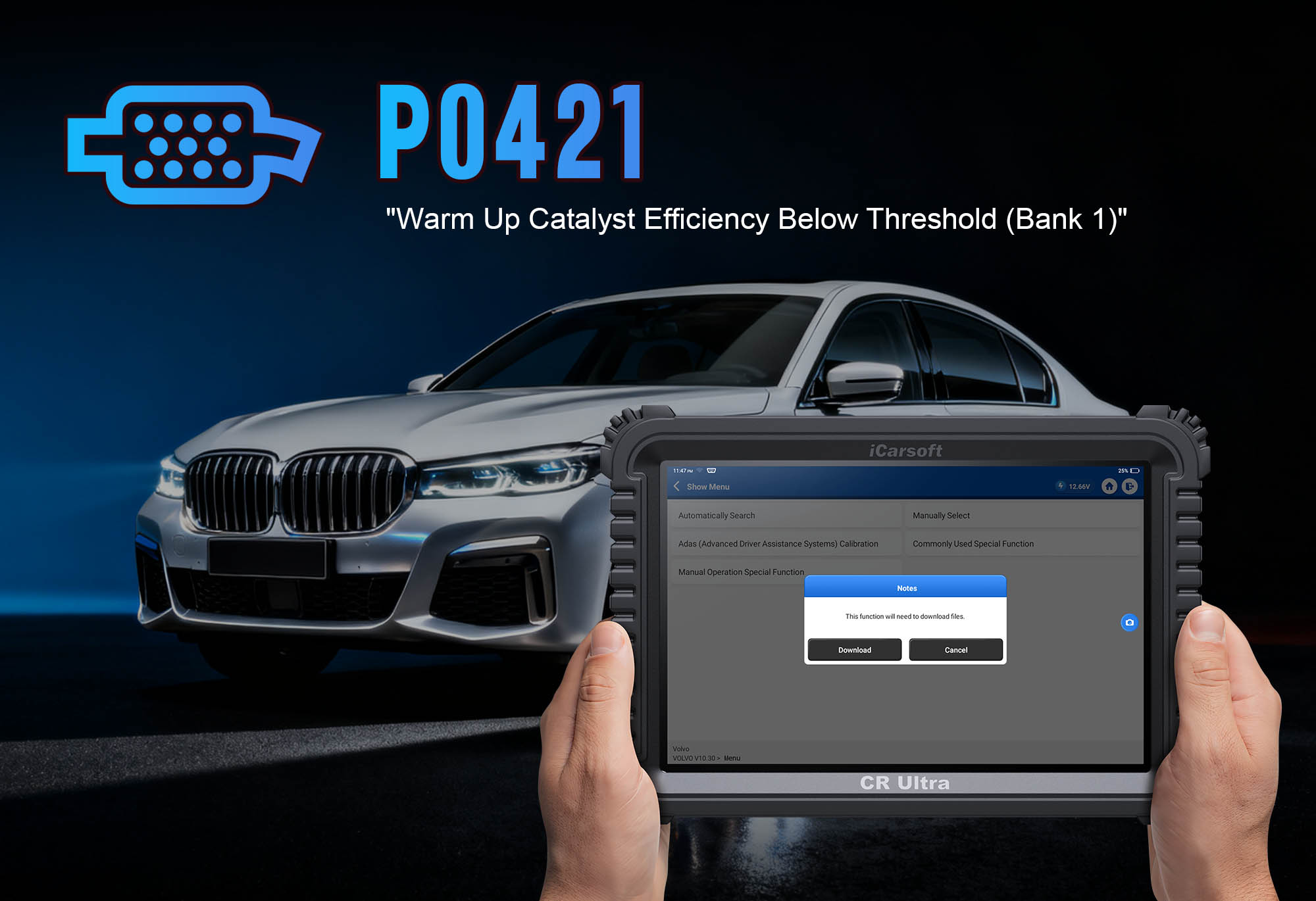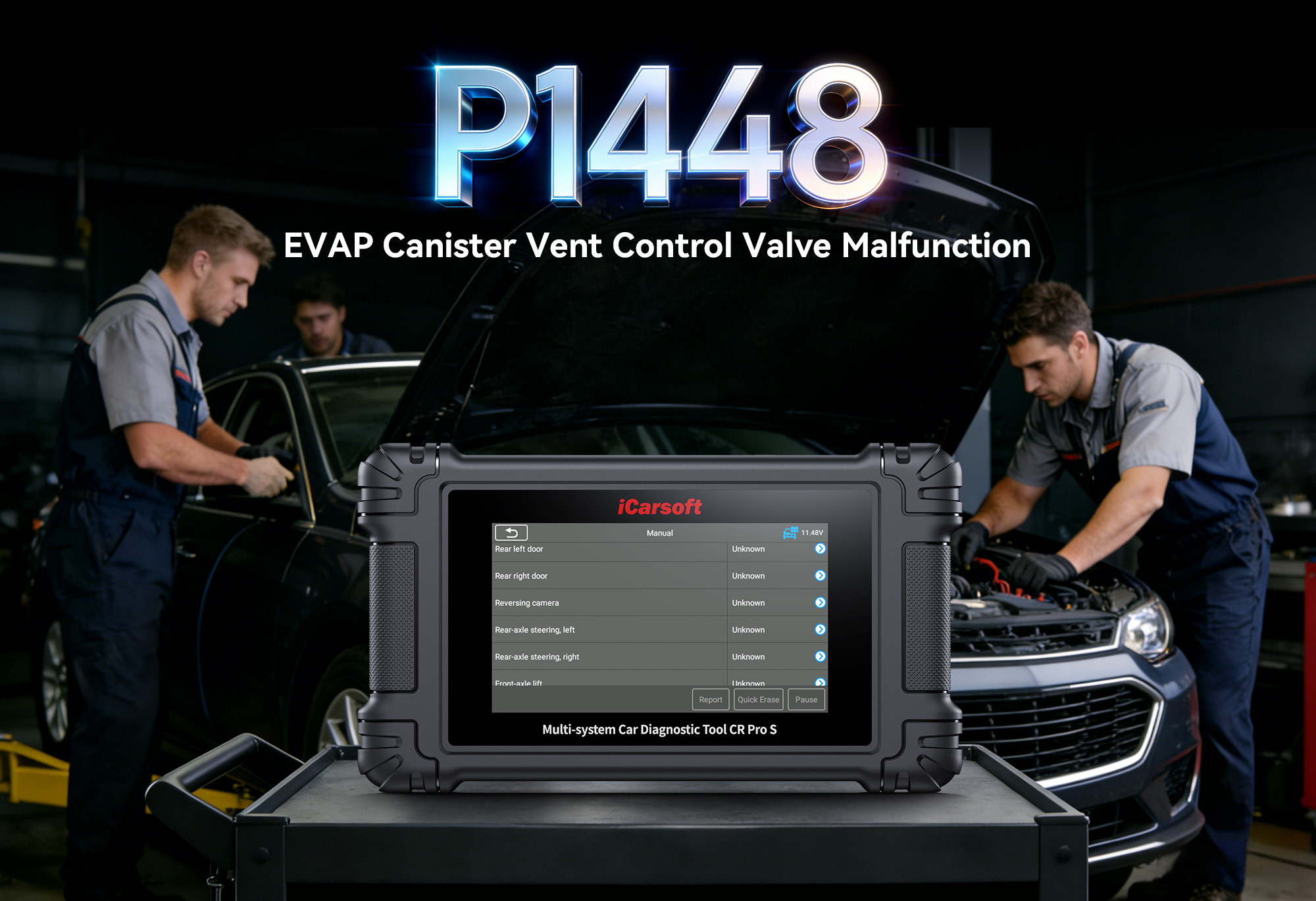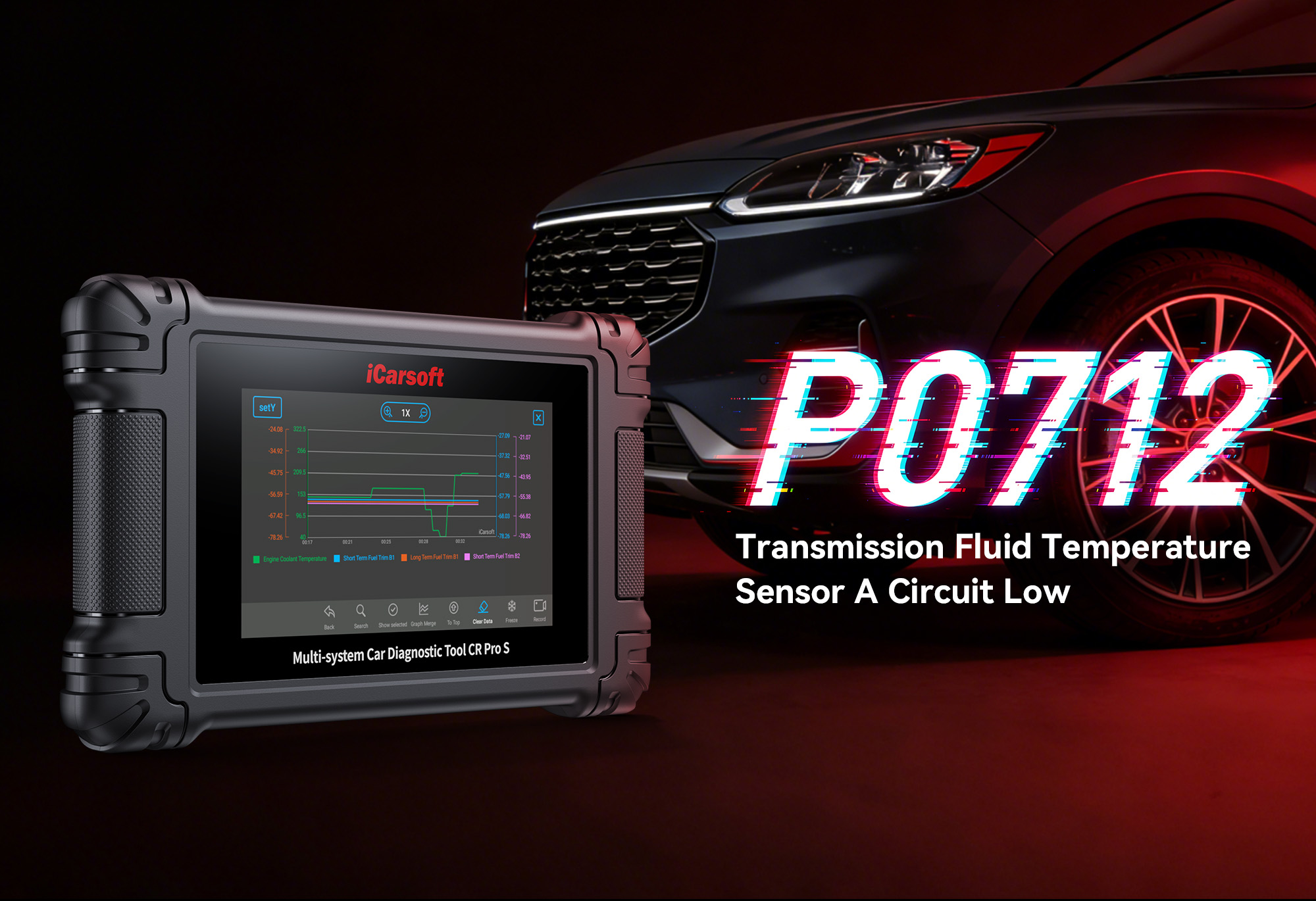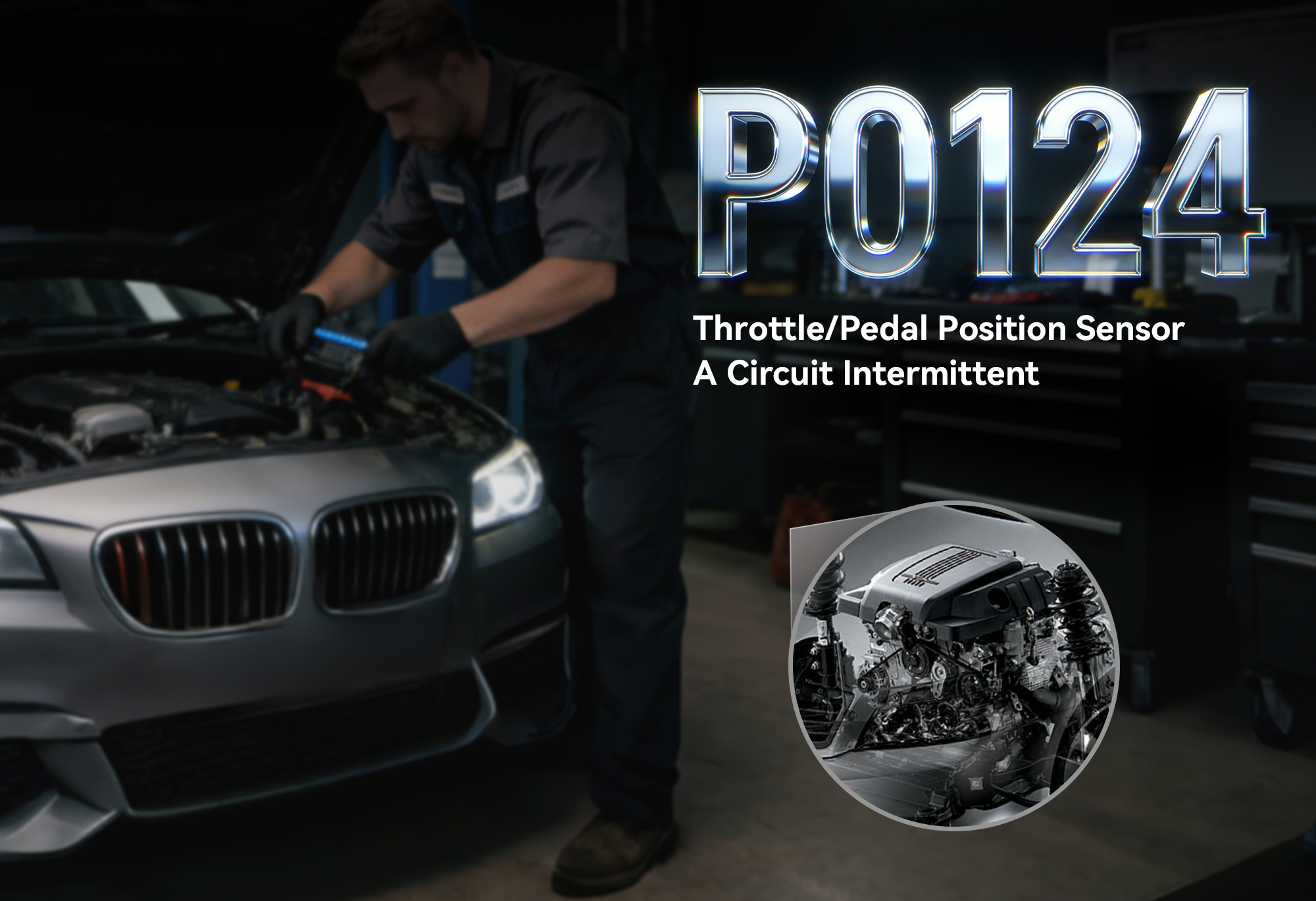P0421 Code: How to Diagnose & Fix Warm-Up Catalyst Efficiency with iCarsoft CR Ultra
If your check engine light stays on and you notice reduced fuel efficiency or a faint sulfuric smell from the exhaust, a diagnostic scan will likely return P0421. This OBD-II code stands for "Warm-Up Catalyst Efficiency Below Threshold (Bank 1)," indicating that the catalytic converter responsible for early emissions control (the "warm-up" catalyst) on Bank 1 is not operating at sufficient efficiency.
Catalytic converters reduce harmful exhaust gases (like carbon monoxide and hydrocarbons) into less toxic substances. The warm-up catalyst—often integrated with the main converter or located closer to the engine—activates quickly after startup to handle cold-engine emissions, when most pollutants are released. P0421 triggers when the Engine Control Module (ECM) detects that this catalyst isn’t cleaning exhaust gases effectively during the critical warm-up phase (typically the first 5–10 minutes of operation). Left unaddressed, this can lead to failed emissions tests, reduced engine performance, and potential damage to the main catalytic converter.
Basic scanners may only flag "catalyst efficiency low" but can’t distinguish between warm-up and main converters or identify root causes like oxygen sensor faults. The iCarsoft CR Ultra, with its specialized catalyst efficiency tests, oxygen sensor waveform analysis, and exhaust gas monitoring, solves this. Let’s explore how to diagnose and resolve P0421 using this professional-grade tool.
Understanding P0421: Causes & Key Symptoms
A failing warm-up catalyst disrupts emissions control, creating symptoms tied to inefficient exhaust treatment—especially during cold starts. These clues help identify whether the catalyst itself or another component is at fault.
Key Symptoms of P0421
-
Persistent Check Engine Light: Illuminates when the ECM detects the warm-up catalyst’s efficiency is 20–30% below manufacturer thresholds for 2+ drive cycles.
-
Reduced Fuel Efficiency: The ECM enriches the fuel mixture to compensate for perceived "lean" conditions, lowering MPG by 5–10%.
-
Sulfuric or Rotten Egg Smell: Unprocessed hydrogen sulfide in the exhaust creates a pungent odor, most noticeable during cold starts.
-
Failed Emissions Tests: High levels of hydrocarbons (HC) and carbon monoxide (CO) are common, as the warm-up catalyst can’t handle cold-engine emissions.
-
Hesitation During Warm-Up: The engine may feel sluggish in the first 5–10 minutes of operation, as exhaust backpressure builds due to a partially clogged catalyst.
-
Increased Exhaust Noise: A damaged catalyst (e.g., internal rattling from broken substrate) may create a louder exhaust note.
Common Causes of P0421
|
Cause
|
Description
|
|
Warm-Up Catalyst Degradation
|
Heat damage, oil contamination, or age (80,000–120,000 miles) breaks down the catalyst’s active materials, reducing efficiency.
|
|
Oxygen Sensor Malfunction
|
Faulty upstream/downstream O2 sensors on Bank 1 send incorrect data, leading the ECM to misjudge catalyst efficiency.
|
|
Exhaust Leaks
|
Leaks before the warm-up catalyst draw in outside air, skewing O2 sensor readings and mimicking catalyst failure.
|
|
Fuel System Issues
|
Rich fuel mixtures (clogged injectors, failing regulator) flood the catalyst with unburned fuel, overheating and damaging it.
|
|
Engine Oil Consumption
|
Burning oil (worn valve guides/turbo seals) coats the catalyst’s substrate, blocking gas flow and reducing efficiency.
|
|
Damaged Catalyst Substrate
|
Physical impact or overheating cracks the catalyst’s internal honeycomb structure, reducing surface area for gas treatment.
|
Why iCarsoft CR Ultra Excels at Diagnosing P0421
The CR Ultra outperforms basic scanners with features tailored to catalyst and exhaust system diagnostics—critical for distinguishing between catalyst failure and other underlying issues:
Warm-Up Catalyst Efficiency Testing
Compares upstream/downstream O2 sensor readings during cold starts, isolating warm-up phase issues (unlike generic catalyst tests).
O2 Sensor Waveform Analysis
Captures real-time voltage patterns to identify "lazy" sensors (slow response) that mimic catalyst failure.
Exhaust Leak Detection
Integrates with smoke testing to pinpoint leaks before the catalyst, which can falsely trigger P0421.
3D Exhaust System Mapping
Displays high-res diagrams of Bank 1’s warm-up catalyst, O2 sensors, and exhaust manifold for 200+ vehicle brands.
Fuel Trim Correlation
Cross-references long-term fuel trim data with catalyst efficiency to detect rich mixtures that damage catalysts.
Catalyst Age Tracking
Logs vehicle mileage and catalyst performance trends to determine if age-related degradation is the cause.
Step-by-Step: Diagnose P0421 with iCarsoft CR Ultra
-
Connect & Confirm the P0421 Code
1. Plug the CR Ultra into your vehicle’s OBD-II port (use included adaptors for older models) and power on the tool.
2. Select your vehicle via Auto VIN Scan (instantly identifies make/model/engine) or manual entry.
3. Navigate to Engine > Fault Codes > Read Codes to confirm P0421. Tap Code Details for vehicle-specific insights (e.g., "Audi A4: Warm-Up Catalyst Efficiency Low; Check O2 Sensors 1 & 2").
-
Locate Bank 1’s Warm-Up Catalyst & O2 Sensors
1. Go to Component Location > Engine > Exhaust System > Bank 1 Catalysts > Warm-Up Catalyst.
2. Use the 3D diagram to identify key components:
- Warm-Up Catalyst: Close to the engine (often part of the exhaust manifold or front downpipe).
- Upstream O2 Sensor (Bank 1, Sensor 1): Before the catalyst (monitors unprocessed exhaust).
- Downstream O2 Sensor (Bank 1, Sensor 2): After the catalyst (measures treated exhaust).
- Exhaust Manifold: Common source of leaks near the catalyst inlet.
-
Analyze O2 Sensor Data During Warm-Up
1. Ensure the engine is cold (not started for 4+ hours). Start it and let the CR Ultra record data for the first 10 minutes.
2. Navigate to Engine > Live Data > Exhaust > Bank 1 O2 Sensors & Catalyst and monitor:
- Upstream vs. Downstream Voltage: Healthy catalyst shows upstream fluctuations (0.1–0.9V) and steady downstream (0.4–0.6V). P0421 = voltages nearly identical (<0.1V difference).
- Warm-Up Efficiency Score: Calculated by the tool (0–100%). Scores <70% confirm catalyst underperformance.
- Sensor Response Time: Upstream should respond in <100ms, downstream in <200ms. Slower = faulty sensor.
-
Test O2 Sensor Functionality
1. Waveform Comparison Test: Go to Special Functions > Engine > Sensor Tests > O2 Sensor Waveform (Bank 1). Compare upstream/downstream patterns:
- Healthy: Upstream has sharp peaks/valleys; downstream has flattened peaks.
- Faulty: Identical waveforms (catalyst failure or bad downstream sensor).
2. Sensor Heater Test: Check Special Functions > Engine > Sensor Tests > O2 Heater Resistance (Bank 1). Normal = 10–40 ohms. High resistance = heater failure (replace sensor).
-
Check for Exhaust Leaks & Fuel System Issues
1. Exhaust Leak Detection: Use Special Functions > Exhaust Smoke Test. Introduce smoke into the exhaust manifold—leaks before the catalyst will release smoke. Focus on:
- Gasket between manifold and catalyst.
- Welds/seams on the catalyst housing.
2. Fuel Trim Analysis: Check Engine > Live Data > Fuel System > Long-Term Fuel Trim (Bank 1). Persistently high values (+10% to +20%) = rich mixture (check injectors/regulator).
-
Inspect the Warm-Up Catalyst
1. External Inspection: Check for dents, discoloration (bluish tint = overheating), or oil residue (oil consumption issue).
2. Internal Rattle Test: Tap the catalyst with a rubber mallet. Rattling = broken substrate (replace catalyst).
3. Backpressure Test: Use the CR Ultra with a backpressure gauge. Readings >1.5 psi at idle = clogged catalyst.
-
Repair & Clear P0421
1. Fix the root cause:
- Faulty O2 sensors: Replace with OEM parts (use Part Lookup).
- Exhaust leaks: Repair with new gaskets/clamps (follow Torque Guide).
- Rich fuel mixture: Clean/replace injectors; repair fuel pressure regulator.
- Oil consumption: Address worn valve seals/piston rings.
- Failed catalyst: Replace with OEM/aftermarket unit (ensure warm-up duty design).
2. Clear the code: Navigate to Engine > Fault Codes > Clear Codes to delete P0421.
-
Validate the Repair
1. Repeat warm-up efficiency test: Cold start the engine; efficiency score should exceed 80%, with clear sensor voltage differences.
2. Test drive for 40–50 minutes (multiple cold starts): Ensure no check engine light return.
3. Run Emissions Pre-Test: Verify HC/CO levels are within legal limits.
Preventing P0421 Recurrence
Use the iCarsoft CR Ultra to protect the warm-up catalyst and extend its lifespan:
-
O2 Sensor Maintenance: Set Service Reminder to replace O2 sensors every 60,000–100,000 miles—failing sensors accelerate catalyst wear.
-
Fuel System Care: Use Fuel Quality Monitor to detect rich mixtures. Add fuel system cleaner every 5,000 miles.
-
Oil Consumption Checks: Monitor oil levels and use PCV System Test to catch oil leaks before catalyst contamination.
-
Quarterly Quick Scans: Run Quick Scan to track catalyst efficiency trends—address minor drops (75%→70%) before P0421 triggers.
Conclusion
P0421’s warm-up catalyst inefficiency threatens emissions compliance and engine performance, but the iCarsoft CR Ultra simplifies diagnosis with targeted tests for cold-start conditions, O2 sensor accuracy, and exhaust leaks. Whether replacing a sensor, fixing a leak, or installing a new catalyst, this tool ensures you resolve the root cause—restoring clean emissions, fuel efficiency, and reliable operation.
With the CR Ultra, tackling "catalyst efficiency faults" becomes a precise process, keeping your vehicle compliant and protected from costly downstream damage.
FAQs About P0421 Code
Q: Can I drive with P0421?
A: Short-term driving is possible, but prolonged use risks failed emissions, reduced MPG, and damage to the main catalytic converter. Address P0421 within 2–4 weeks.
Q: How much does it cost to fix P0421?
A: $100–$300 for O2 sensors; $200–$800 for a warm-up catalyst (aftermarket/OEM). Professional labor adds $150–$300. The CR Ultra ($200–$300) saves money by avoiding unnecessary catalyst replacement.
Q: Will replacing O2 sensors fix P0421?
A: If faulty sensors are the cause, yes. The CR Ultra’s waveform analysis helps confirm whether sensors or the catalyst are at fault—preventing wasted repairs.
Q: Can a bad spark plug cause P0421?
A: Indirectly—worn spark plugs cause misfires, leading to unburned fuel entering the catalyst. This overheats and damages the catalyst, eventually triggering P0421.





